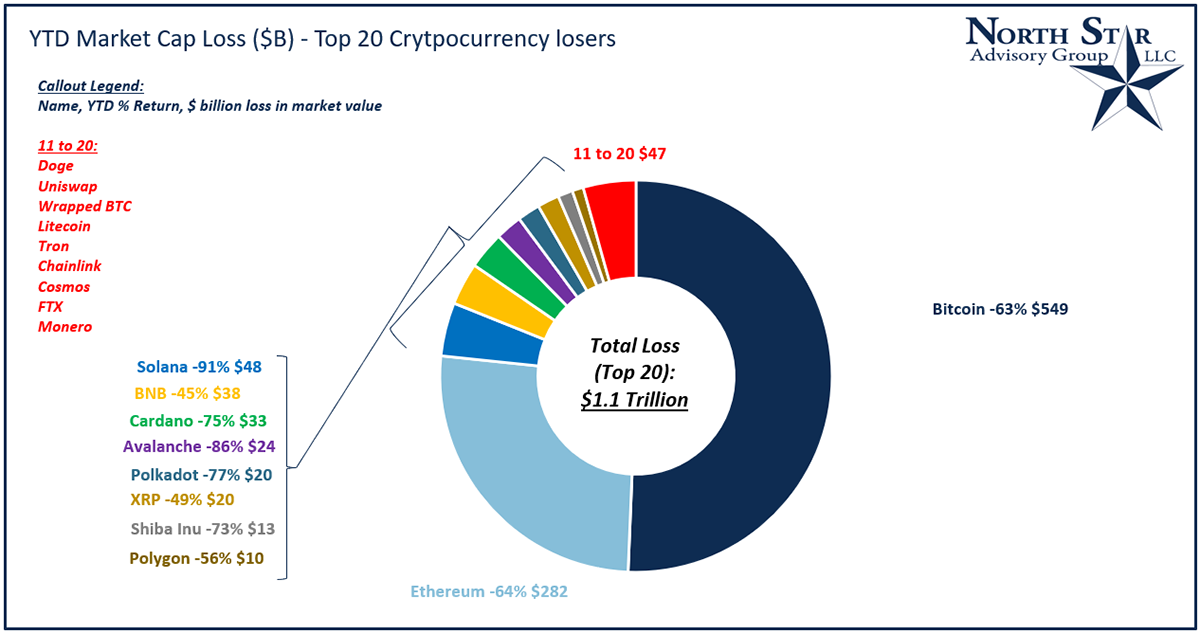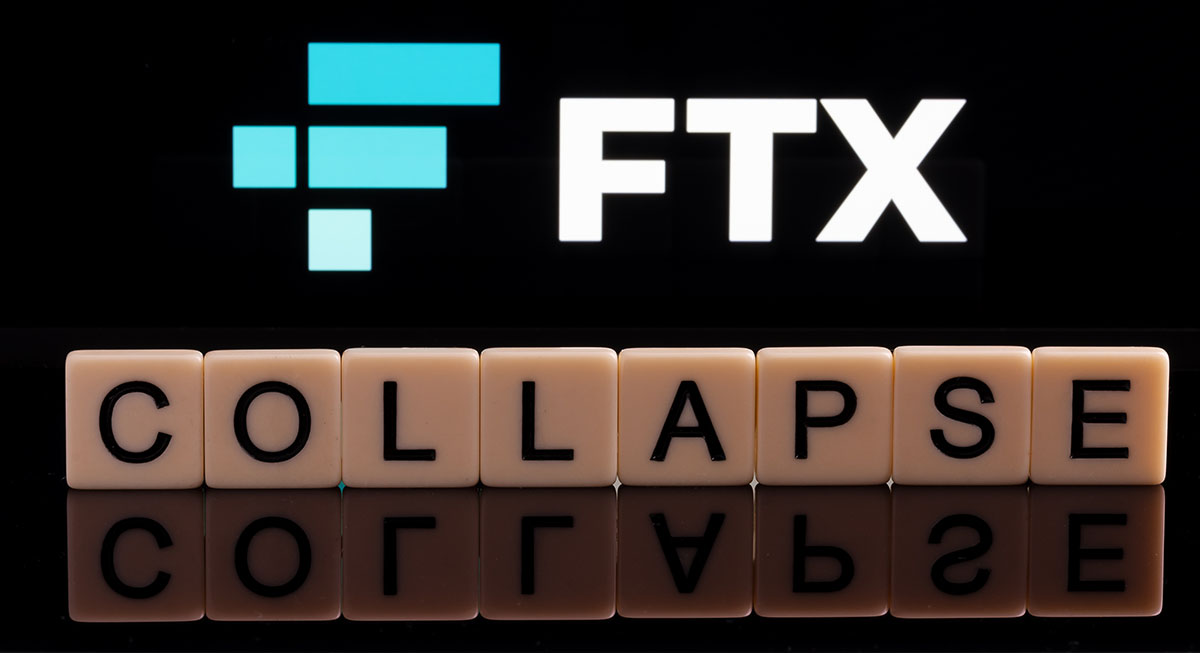Each month we ask clients to spend a few minutes reading through our newsletter with the goal of raising their investor IQ. This month as snow and cold weather settle into many parts of the country, we focus on 2022’s crypto winter, the government’s continued freeze on student loan payments and the thawing of the stock markets.
- Student loan freeze continues
- Stock fall & thaw
- Crypto winter
- FTX collapse
- NSAG News
- Where will the equity markets go next?
Student loan freeze continues
26 million Americans have applied for student loan debt relief and the government believes up to 40 million borrowers could be eligible. These borrowers are sitting on the edge of their seats waiting for forgiveness while law suites are addressing concerns that the program is an unconstitutional exercise of presidential executive power. Concerns include, but are not limited to, the total cost of the forgiveness, fairness of forgiveness, which loans are included and the size of forgiveness for borrowers.
It is expected to take weeks or even months to work through the now pending lawsuits. Therefore, the pause on student loan payments and collections has been extended. The student loan payment pause is extended until 60 days after the Department of Education is permitted to implement the debt relief program, or the litigation is resolved. If the program has not been implemented and the litigation has not been resolved by June 30, 2023, payments will resume 60 days after that around September 1, 2023. The government will notify borrowers before payments restart.
NSAG encourages you to visit StudentAid.gov to explore more affordable repayment options, other debt forgiveness programs, and sign up for notifications.
Stock fall & thaw
According to USAspending.org, 43 agencies in the US allocated total budgetary resources of $4.55 trillion and these agencies have increased the US money supply by distributing a total of $4.04 trillion to help fight the financial impacts of COVID. While a $4 trillion increase in money supply has been a major contributor to inflation, The Fed is working to unwind its prior increases in the money supply. So far this year, we have also seen a more than $10 trillion decrease in stock values inside the Russell 3000. This decline goes a long way towards The Fed’s goal of impacting wealth in the US.
Investing in publicly traded companies can bring the risk of large losses. New ideas might not have a big enough moat from competition, laws and regulatory framework may not change fast enough to turn a profit, hyper growth companies may see their growth dry up, well-established companies may see their business model struggle and others simply make bad decisions. Even if a well-established business is executing well, tighter monetary conditions driven by the Federal Reserve may lead to lower economic growth forecasts and higher interest rate levels, both of which have a negative impact on asset prices.
This month we provide two sample charts of well know companies and their respective performance through 2022. The first chart contains the top 20 losers (based on market value lost in $) within the Russell 3000 index. The second chart contains the top 20 losers (based on market value lost in $) within the emerging technology group of leaders over the past two to three years.
In 2022, all Russell 3000 constituents have lost, in aggregate, around $9.1T of market value through 11/30/2022. This number includes all gainers and losers for the year. When aggregating the top 20 names based on market value lost, these companies account for around $5.4T of the total $9.1T in lost market value.
When looking at the emerging technology group of the market, the top 20 losers are down 60-80% each and represent a total market value loss in 2022 of around $526B, as of 11/30/2022!
Crypto winter
Free money and low interest rates were leading contributors to speculative investing into cryptocurrencies (crypto), crypto exchanges and non-fungible tokens (NTFs). From our perspective, these “investments” into crypto are and were more like speculative gambling than investing.
Why do we suggest that crypto is speculative gabling versus investing?
In the world of finance, speculation, or speculative trading, refers to the act of conducting a financial transaction that has substantial risk of losing value but also holds the expectation of a significant gain or other major value. With speculation, the risk of loss is more than offset by the possibility of a substantial gain or other recompense.
An investor who purchases a speculative investment like crypto or NTFs is likely focused on price fluctuations. While the risk associated with the investment is high, the investor is typically more concerned about the greed of generating a profit based on market value changes for that investment than on long-term investing.
Without the prospect of substantial gains, there would be little motivation to engage in speculation. It may sometimes be difficult to distinguish between speculation and simple investment, forcing the market player to consider whether speculation or investment depends on factors that measure the nature of the asset, expected duration of the holding period and/or amount of leverage applied to the exposure.
Why is crypto breaking now?
How much has been lost in Crypto in 2022?

FTX collapse

Clients, friends and family are asking if we are following the FTX situation and what insight we might have. Below is our commentary on the fast-unfolding FTX story that will make a great storyline for a future movie.
Who invested in FTX?
It is often said that fear and greed drive investing. It is clear that greed and risk taking was at the heart of those pouring money into FTX. Sequoia, one of FTX’s largest investors, wrote to their clients “We are in the business of taking risk… Some investments will surprise to the upside, and some will surprise to the downside.”
FTX had several rounds of investing which included dozens of investors, including big names like Tom Brady, Gisele Bündchen, Altimeter, Blackstone, Coinbase Ventures, Iconiq Capital, Insight Partners, IVP, Lightspeed Venture Partners, Lux Capital, Mayfield, Multicoin Capital, NEA, Ribbit Capital, SoftBank Vision Fund, SoftBank Vision Fund 2, Temasek, Tiger Global, Third Point Ventures, in addition to large investment of $278 million from Paradigm, $213 million from Sequoia, $150 million from Thoma Bravo and $95 million from the Ontario Teachers’ Pension Plan.
Currently, it is speculated that there could be up to 1 million creditors seeking between $10 billion to $50 billion of liabilities from FTX alone.
To date, NSAG has not recommended investing into cryptocurrency assets, and we do not anticipate this stance to change.
What is FTX and why is it going bankrupt?
At the simplest level, FTX was a Bahamas-based cryptocurrency exchange. The exchange was founded in 2019 and, at its peak in 2021, had more than one million users and was the third largest crypto exchange by volume. The unraveling of FTX's financials is focused on the misappropriation of client funds from FTX into other sister-companies, which were then used to acquire other competitors, clients and even FTX’s native token FTT. As concerns over improper handling of assets and liquidity caused a run on FTT, it in turn put an unrecoverable stress on the myriad of shell companies and transactions that FTX was using, resulting in an almost immediate bankruptcy.
John J. Ray, III, has been brought in as the new CEO. Ray stated that despite having been involved in the bankruptcies of Enron, Residential Capital, Nortel and Overseas Shipholding, "Never in my career have I seen such a complete failure of corporate controls and such a complete absence of trustworthy financial information as occurred here. From compromised systems integrity and faulty regulatory oversight abroad, to the concentration of control in the hands of a very small group of inexperienced, unsophisticated and potentially compromised individuals, this situation is unprecedented." Let that settle in for a moment… the guy that handled Enron’s bankruptcy essentially said that he has never seen anything as bad as FTX.
When did FTX go under?
Where will FTX’s liquidation take place?
FTX’s Bahamas-based headquarters will present a challenge for all involved. While a wave of bankruptcy filings have taken place in the US, securities regulators in the Bahamas are seeking to control FTX bankruptcy proceedings.
While jurisdiction of control and liquidation procedures will also take some time to sort out, US regulators are stressing the importance of US investors to understand the risks of investing in assets and companies domiciled outside of the US, in particular for unregulated or under-regulated assets.
Why isn’t regulation the solution?
What happens next?
The media will have a well-needed break from politics as they have a field day on the absurdity of the FTX story and the participants. Many of the largest investors will be challenged on their level of due diligence, spokespeople will come under question and ultimately many of the investors will lose the majority if not all of the money they put in.
Other companies may follow the same fate as FTX. For example, BlockFi filed for Chapter 11 bankruptcy November 28, 2022. In July 2022, BlockFi avoided bankruptcy with an investment from FTX.
We expect US regulators and politicians will hold meetings and discuss regulating the crypto market. These meetings will likely be more symbolic than productive. We will likely see the largest regulations arrive when the US, and other countries, start deploying their own digital dollars.
Please do not hesitate to contact us to ask questions or to learn more about this subject.
NSAG News
After a little over a year in the financial services industry Kate Cizmadia has decided to make a career change away from financial services. In November 2022, Kate departed NSAG for a newly created remote position managing the digital storage and organization of estate documents for Key Bank. Kate was an exemplary employee, and we wish her the best of luck in her new career path.
Meet NSAG’s new Paraplanner…
Meet NSAG’s new CFP®…
In November, NSAG hired an additional Certified Financial Planner™ (CFP®). Gage will fill this new position for NSAG, and he will focus on managing the administration aspects of NSAG’s 401(k) platform as well as assisting employees and their families with education and comprehensive financial planning.
Gage joins NSAG with more than six years of investment experience. In addition to his CFP®, Gage also has obtained certifications for Retirement Income Certified Professional (RICP), IRS Enrolled Agent (EA), Series 7 & 65, and Life & Health Insurance Licenses.
We look forward to sharing more about Forrest and Gage when they officially start in January 2023.
Where will the equity markets go next?
Market volatility has been the story of 2022 with no one factor being solely responsible for the volatility. The strength of the underlying economy has really held up well while being tested by a combination of supply chain issues, high inflation, The Federal Reserve, Russia/Ukraine war, commodity prices, strong US Dollar, and the speculative collapse of crypto, NTFs, SPACs and IPOs.
We believe that the global economies are in a basing process right now. Historically speaking, market returns tend to be larger than average after the economy can make a base and resume growth. Before the base can officially be put in, many companies need to work through their excess inventory levels over the next two to three months.
In October, NSAG posted that the markets were at record oversold conditions. In November, NSAG focused on certain markets that had crowed trades that could lead to violent volatility in the other direction faster than many investors can react. For December, we see markets at a point of fair valuation.
While the last 11 months has tested the resolve of many investors, we still believe we are in a secular bull market, which started in 2010 and typically lasts around 15-20 years. However, this secular market is likely to last longer due to a slow start in 2010-2013. It is not uncommon to have bear market pullbacks inside of longer secular bull markets. We saw a bear market in 2020 due to COVID and the markets entered and exited bear market territory three times already in 2022 (May, June & October).
We are passionately devoted to our clients' families and portfolios. Let us know if there’s somebody who would benefit from discovering the North Star difference, or if you just need a few minutes to talk. As a small business, our staff appreciates your continued trust and support.
Please continue to send in your questions and see if yours gets featured in next month’s Timely Topics.
Best regards,


Mark Kangas, CFP®
CEO, Investment Advisor Representative


